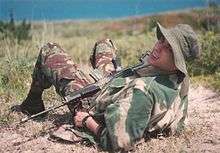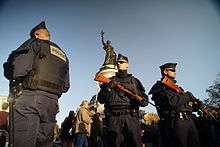Ruger Mini-14
| Ruger Mini-14 | |
|---|---|
|
The Mini-14 GB | |
| Type |
|
| Place of origin | United States |
| Service history | |
| Used by | See Users |
| Production history | |
| Designer | L. James Sullivan, William B. Ruger |
| Designed | 1967–73 |
| Manufacturer | Sturm, Ruger & Company, Inc. |
| Produced | 1973–present |
| Variants |
See Variants:
|
| Specifications | |
| Weight | 6 lb 6oz (2.90 kg) |
| Length | 37.25 in (946 mm) |
| Barrel length |
|
|
| |
| Cartridge |
|
| Action | Gas-operated, rotating bolt |
| Rate of fire |
|
| Muzzle velocity | 3240 ft/s (990 m/s) |
| Feed system | 5-, 10-, 20-, or 30-round factory box magazine. Numerous aftermarket magazines and drums. |
| Sights | Iron sights |
The Mini-14 is a lightweight .223 caliber semi-automatic rifle manufactured by Sturm, Ruger & Co. that is popular with law enforcement, security personnel, hunters, ranchers and target shooters. It is made in a number of variants including the Ranch Rifle with an integral scope base on the receiver, the Mini Thirty which is chambered for 7.62×39mm, and the AC-556, a select-fire assault rifle.
History and design


The Mini-14 was first introduced in 1973 by Sturm, Ruger & Co.[1] The name Mini-14 was coined because it resembles a smaller version of the military M14 rifle.[2] Designed by L. James Sullivan[3] and William B. Ruger, it incorporated numerous innovations and cost-saving engineering changes. The Mini-14 rifle employs an investment cast, heat-treated receiver and is mechanically similar to the M1 Garand rifle, with a self-cleaning, fixed-piston gas system.[1][4] Initial rifles were produced with a complex, exposed bolt hold open device with no button for manual engagement. Stocks were somewhat angular and heat shields were made of wood. These rifles, with serial number prefixes before 181, were tooled and redesigned with a new stock, new bolt hold-open mechanism, and other small changes.[5]
The original Mini-14 rifle had a rear aperture sight with large protective wings, and no integral scope bases. In 1982, Ruger introduced the Ranch Rifle with an integral scope base on the receiver, a new folding aperture rear sight and factory scope rings. It introduced a plastic heat shield and ejected spent cartridge cases at a lower angle to avoid hitting low-mounted scopes.
In 1987, Ruger introduced the Mini-Thirty rifle chambered for the Russian 7.62×39 mm cartridge. At the time, large quantities of surplus military ammunition was being imported into the United States at rock bottoms prices. Also, the 7.62×39 mm is ballistically similar to the 30-30 Winchester cartridge. As a result, the Mini-Thirty proved to be an effective deer rifle.
The design was overhauled to improve accuracy and update the styling while at the same time reducing production costs. The standard Mini-14 was discontinued and the name became the family name for all Mini-14 type rifles. All new models are now based on the Ranch Rifle design, with integral scope bases.
As of 2005, all new Mini-14 type rifles are built with integral scope bases, non-folding ghost ring aperture rear sight and a winged front sight similar to that used on the Ruger Police Carbine.[5] These new rifles were designed to improve overall accuracy. They have new iron sights and a modified gas system designed to reduce barrel vibration.[5][6] These new Mini-14s are capable of shooting 2 inch groups at 100 yards or 2 Minute of angle (MOA) accuracy.[6] These new upgraded Ranch Rifles with serial numbers beginning with 580 and are sometimes referred to as 580 series Ranch Rifles.[6]
Sometime between 2007 and 2008, Ruger added a heavier tapered barrel to the Mini series. The heavier barrel had an overall larger diameter with the barrel visibly becoming thicker in the final inches as the barrel approaches the gas block from the muzzle. These changes combined with tighter tolerances result in greater potential accuracy.[4]
All Mini-14 type rifles are available in stainless steel or blued finish with hardwood, synthetic, or laminated stocks, and 16.5-inch (420 mm) and 18.5-inch (470 mm) barrels.[6] Most Mini-14s have a classic sporter appearance, in contrast to comparable autoloading rifles such as the AK-47 and AR-15.[6] However, Ruger now offers some Mini-14 rifles in a black ATI adjustable folding stock with a pistol grip. Also, Ruger factory-fresh 20 and 30-round steel-magazine are readily available.[6]
Variants
Ranch Rifle
The Ranch Rifles are currently the most basic models, they generally come in a wood rifle stock or synthetic stock with black or stainless receiver, and feature an 18.5" tapered barrel. Although some are available with a 16" barrel such as the NRA edition. These rifles feature an adjustable ghost ring rear sight and winged front sight. They are sold with a 20-round detachable magazine; however, in some states like New York, New Jersey and California, where certain magazines are banned due to their capacity, the rifles are sold with 5-round magazines instead. This model will chamber both .223 Remington and 5.56×45mm NATO ammunition.[5]
Target Rifle
Introduced in 2007,[7] the "Target Rifle" version has a 22-inch (560 mm) cold hammer-forged heavy barrel, adjustable harmonic tuner with adjustable minute-of-angle accuracy and either a laminated wood or Hogue overmolded synthetic stock.[8][9] The Target Rifle does not have iron sights and comes with scope rings and Picatinny rail mount.[9] The Target Rifle is only designed for the .223 Remington round, 5.56 NATO is not warranted by Ruger.[10]
NRA Model
Introduced in 2008, the "NRA Model", is a Ranch Rifle with a shorter 16.25-inch (413 mm) barrel, two 20-round magazines (where permissible), and a polymer stock with a gold National Rifle Association medallion. Ruger made a donation to the NRA-ILA for every rifle sold.[11]
Tactical Rifle

Introduced in 2009,[12] the "Tactical Rifle" is a newer model with a 16.12" barrel (1:9" RH twist rate) with flash suppressor, and are available with a standard fixed stock/forend, or a collapsible ATI brand stock with Picatinny rails. This rifle is marked on the receiver as "Tactical Rifle". It is very similar to the Ranch Rifle model except for the "bird cage" flash suppressor, folding stock, and shorter barrel. This model will chamber both .223 Remington and 5.56×45mm NATO ammunition.[13]
Mini-Thirty
In 1987, Ruger began production of the Mini-Thirty. The Mini-Thirty is chambered for the Russian 7.62×39mm cartridge, used in the SKS and AK-47, as many states prohibit hunting of deer with calibers smaller than 6 mm (.243 in). The 7.62×39mm has ballistics similar to the well-known .30-30 Winchester. The Mini-Thirty was only available as a Ranch Rifle, with integral scope base. Current production Mini-Thirtys are similar to Mini-14's except for caliber. The Mini-Thirty is available with a 16.12" or 18.50" barrel, with a twist rate of 1:10" RH.[14]
Government models
Mini-14 GB

The Mini-14 GB models feature a pistol grip, side folding stock, 20 & 30-round magazine, bayonet lug, threaded barrel, and flash suppressor. The GB models also come with standard rifle stocks. The "GB" stands for "government bayonet".[15] The Mini-14 GB models sales are intended for only the Law Enforcement, Military and Private Security market, and can only be found in their Law Enforcement Catalog.[16] However, some have entered the civilian market.[17]
AC-556
The AC-556 is a selective-fire version of the Mini-14 marketed for military and law enforcement use. The AC-556GF is fully automatic.[15] The design incorporates a selector on the right/rear of the receiver to select either semi-automatic, 3-round burst, or full-automatic fire modes; the manual safety at the front of the trigger guard operates the same as a standard Mini-14. The front sight is winged and incorporates a bayonet lug. The 13-inch (330 mm) or 18-inch (460 mm) barrel incorporates a flash suppressor, which can be used to launch approved tear-gas and smoke grenades. A folding stock was used on the AC-556F and AC-556K. The rifle came equipped with 20-round magazines and a 30-round version was available for a time. The AC-556 was dropped from production in 1999 and Ruger stopped offering service for the rifle in 2009.[18][19]
Mousqueton A.M.D
In France, the AC-556 is known as the Mousqueton A.M.D. where it was used by several governmental agencies within the French Interior Ministry: the Police Aux Frontières ("P.A.F."—Border Police), the Police Nationale Compagnies Républicaines de Sécurité (or "C.R.S."—Riot Control Brigade) and even the Army's Groupe d'Intervention de la Gendarmerie Nationale ("GIGN") special operations unit.
Straight pull action
A small number of straight-pull only Mini-14 and Mini-30 rifles were manufactured for sale in the United Kingdom as a result of legislation which banned semi-automatic centerfire rifles in 1988.[20]
.jpg)

Other calibers
.222 Remington
Ruger produced a .222 Remington caliber model as of 1984.[21] These rifles were made mostly for the European market and were discontinued in the early 1980s.[22]
6.8 mm Remington
In 2007, Ruger began production of the Mini-6.8 utilizing the commercial 6.8mm Remington SPC cartridge.[23] However, they were discontinued in 2012, and are no longer listed in the Ruger catalog.
300 Blackout
In 2015 Ruger introduced the Mini-14 Tactical chambered in .300 AAC Blackout.
Accessories
There is a wide range of after-market accessories available for the Mini-14 and Mini-30 to include numerous stocks, magazines, weaver and picatinny rail mounts.[5]
Users


 Australia: Previously used in the 1980s/1990s by the New South Wales Department of Corrective Services.[24]
Australia: Previously used in the 1980s/1990s by the New South Wales Department of Corrective Services.[24] Bermuda: The Royal Bermuda Regiment has used the Mini-14GB/20 as its standard service rifle since 1983. Original wooden stocks were replaced with Choate black plastic stocks about 1990.[25][26] The regiment received L85A2 rifles in August, 2015, and the Ruger will be phased out of use by January, 2016.[27]
Bermuda: The Royal Bermuda Regiment has used the Mini-14GB/20 as its standard service rifle since 1983. Original wooden stocks were replaced with Choate black plastic stocks about 1990.[25][26] The regiment received L85A2 rifles in August, 2015, and the Ruger will be phased out of use by January, 2016.[27] France: Mousqueton A.M.D. variant used by French police forces (Police Aux Frontières, GIGN, CRS).[28][29]
France: Mousqueton A.M.D. variant used by French police forces (Police Aux Frontières, GIGN, CRS).[28][29] Honduras[30]
Honduras[30] Rhodesia: Mini 14s were used in Rhodesia[31]
Rhodesia: Mini 14s were used in Rhodesia[31] United Kingdom: The Surrey Constabulary Firearms Support Team (now known as the Tactical Firearms Unit) was armed with Mini-14s in the 1980s modified with Choate stocks.[32][33][34]
United Kingdom: The Surrey Constabulary Firearms Support Team (now known as the Tactical Firearms Unit) was armed with Mini-14s in the 1980s modified with Choate stocks.[32][33][34]  United States: Mini-14s were used by the New York City Police Department Emergency Service Unit[35] with the rifles eventually being replaced by the M4 carbine.[36] The NYPD's Organized Crime Control Bureau is armed with the Mini-14s.[36] The Mini-14 is the main rifle used by the California Department of Corrections and Rehabilitation,[37][38][39] the Georgia Department of Corrections,[40] and the North Carolina Department of Correction.[41] US Marines that serve as guards at certain US embassies are sometimes issued Mini-14s.[42] Delta Force has some Mini-14s in inventory.[43]
United States: Mini-14s were used by the New York City Police Department Emergency Service Unit[35] with the rifles eventually being replaced by the M4 carbine.[36] The NYPD's Organized Crime Control Bureau is armed with the Mini-14s.[36] The Mini-14 is the main rifle used by the California Department of Corrections and Rehabilitation,[37][38][39] the Georgia Department of Corrections,[40] and the North Carolina Department of Correction.[41] US Marines that serve as guards at certain US embassies are sometimes issued Mini-14s.[42] Delta Force has some Mini-14s in inventory.[43]
Criminal use
The Ruger Mini 14 was used in these incidents:
- 1986 FBI Miami shootout, which resulted in FBI agents and law enforcement agencies switching to more powerful guns.[44][45][46]
- École Polytechnique Massacre, which resulted in the Canada Firearms Act, 1995[47][48] and new police response procedures.[49]
In popular culture
- The Ruger Mini-14 were seen extensively in the The A-Team, an NBC television series that aired from 1983 to 1987 in a multitude of episodes.[50] It was chosen because of its reputation for reliably firing blanks, which tend to clog a gun's action.[51]
- George Clooney uses the Ruger Mini-14 as a sniper rifle with collapsible stock, side-mounted scope and large homemade silencer in the 2010 film The American.[52]
References
- 1 2 Military Small Arms Of The 20th Century, 7th Edition, 2000 by Ian V. Hogg & John S. Weeks, p.295
- ↑ Jack Lewis; Robert K. Campbell; David Steele (26 September 2007). The Gun Digest Book of Assault Weapons. Iola, Wisconsin: Gun Digest Books. pp. 87–89. ISBN 0-89689-498-3.
- ↑ Ezell, Virginia Hart (November 2001). "NDM Article - Focus on Basics, Urges Small Arms Designer". Archived from the original on October 8, 2006.
- 1 2 J. Guthrie. "The Mini Grows Up--Again". Rifle Shooter.
- 1 2 3 4 5 Lewis, Jack (28 February 2011). "Today's Mini-14". Assault Weapons. Iola, Wisconsin: Gun Digest Books. pp. 128–130. ISBN 1-4402-2400-5.
- 1 2 3 4 5 6 Sheetz, Brian (22 March 2016). "Five Reasons To Reconsider The Ruger Mini-14". American Rifleman.
- ↑ "STURM, RUGER & CO., INC. RIFLES: SEMI-AUTO, CENTERFIRE MINI-14 RANCH RIFLE". Blue Book of Gun Values. Retrieved 2016-11-07.
- ↑ "Ranch Rifle Target model with overmolded stock" (PDF). Ruger-firearms.com (Press release). Retrieved 2016-11-07.
- 1 2 "Ruger® Mini-14® Target Rifle Autoloading Rifle Models". Ruger.com. Retrieved 2016-11-07.
- ↑ Dan Shideler (7 August 2011). Gun Digest 2012. Iola, Wisconsin: Gun Digest Books. pp. 439–440. ISBN 1-4402-1447-6.
- ↑ "Mini-14 Ranch Rifles & Mini Thirty Rifles - NRA Mini-14 Rifle". Archived from the original on August 21, 2008.
- ↑ "STURM, RUGER & CO., INC. RIFLES: SEMI-AUTO, CENTERFIRE MINI-14 TACTICAL RIFLE FIXED STOCK". Blue Book of Gun Values. Retrieved 2016-11-07.
- ↑ Publishing, Skyhorse (1 November 2009). Shooter's Bible. Skyhorse Publishing Inc. p. 43. ISBN 978-1-60239-801-6.
- ↑ Shideler, Dan (28 February 2011). "The Hammer of Thor". Gun Digest Book of Deer Guns: Arms & Accessories for the Deer Hunter. Iola, Wisconsin: Gun Digest Books. pp. 42–43. ISBN 1-4402-2666-0.
- 1 2 Wilson, Robert (10 November 2015). Ruger and His Guns: A History of the Man, the Company & Their Firearms. Skyhorse Publishing Company, Incorporated. p. 579. ISBN 978-1-5107-0926-3.
- ↑ Ramos, Joe (1982). The Mini-14 Exotic Weapons System. Boulder, Colorado: Paladin Press. ISBN 0873645278.
- ↑ Peterson, Phillip (30 September 2008). Gun Digest Buyer's Guide To Assault Weapons. Iola, Wisconsin: F+W Media. pp. 198–200. ISBN 978-1-4402-2444-7.
- ↑ "Ruger AC-556 Select Fire Military Rifle". 1 February 2013. Retrieved 2 August 2013.
- ↑ Chris Bishop; Tony Cullen; Ian Drury (1988). The Encyclopedia of World Military Weapons. Crescent Books. p. 246. ISBN 978-0-517-65341-8.
- ↑ Bishop, Chris (1996). The Vital Guide to Combat Guns and Infantry Weapons. Airlife. p. 44. ISBN 978-1-85310-539-5.
- ↑ Brister, Bob (1984). "News from the 2 R's". Field & Stream. 88 (10): 110. ISSN 8755-8599. Retrieved 2 August 2013.
- ↑ Standard Catalog of Ruger Firearms. Jerry Lee. "F+W Media, Inc.", Dec 16, 2014. Antiques & Collectibles. page 78
- ↑ Ramage, Ken; Sigler, Derrek (19 November 2008). Guns Illustrated 2009. Iola, Wisconsin: F+W Media, Inc. p. 146. ISBN 0-89689-673-0.
- ↑ Graham Williams (July 1, 1988). "NSW Declares Chemical War On Prisoners". Sydney Morning Herald.
Other equipment includes [...] a Ruger .223 gas-operated, semi-automatic carbine (with a range of 2800 metres)
- ↑ "Ruger Mini-14". Bermudaregiment.bm. Retrieved 2016-11-07.
- ↑ "Bermuda Regiment Fitness for Role Inspection". British Defence Staff. November 2005.
- ↑ Rifles worth $1.4m donated to Regiment. By Lisa Simpson. The Royal Gazette. Published 5 August, 2015
- ↑ Martin K.A. Morgan (January 9, 2015). "The Mousqueton A.M.D.— France's Mini-14". Retrieved January 12, 2015.
- ↑ "French Police Mini-14". January 11, 2015. Retrieved January 12, 2015.
- ↑ Gander, Terry J.; Hogg, Ian V. Jane's Infantry Weapons 1995/1996. Jane's Information Group; 21 edition (May 1995). ISBN 978-0-7106-1241-0.
- ↑ Soldier of Fortune magazine, Robert K Brown, 1980
- ↑ Dick Chase; Eric Adams; Mick Wayland; Bob Bartlett. "Firearms Support Team and Firearms Training" (PDF). Retrieved 2011-03-27.
- ↑ "Firearms". Surrey Police. Archived from the original on June 8, 2009. Retrieved 2009-10-29.
- ↑ "Mini-14 Uses". ammoparadise.com.
- ↑ Larry Celona (2002-07-04). "Terror-Wary NYPD testing new assault rifle". New York Post. Retrieved 2009-10-29.
- 1 2 "NYPD boosts training after Mumbai attack". Associated Press & Taipei Times. 2009-02-17. Retrieved 2009-10-29.
- ↑ "Archived copy" (PDF). Archived from the original (PDF) on 2010-01-17. Retrieved 2009-12-24.
- ↑ "Archived copy" (PDF). Archived from the original (PDF) on 2011-07-21. Retrieved 2009-12-24.
- ↑ "Archived copy" (PDF). Archived from the original (PDF) on 2009-12-19. Retrieved 2009-12-24.
- ↑ "Agency Issue (Very Long)". Realpolice.net. Retrieved 2016-11-07.
- ↑ "NC Correction News - May 1998 - DOP Firearms Training". Doc.state.nc.us. Retrieved 2016-11-07.
- ↑ Lewis, Jack (2007). "CQB Combat Training". Gun Digest Book of Assault Weapons (7 ed.). Iola, Wisconsin: Gun Digest Books. p. 134. ISBN 978-1-4402-2652-6. Retrieved 2 August 2013.
- ↑ Mike Ryan (2008). The Operators: Inside the World's Special Forces. p. 187. ISBN 1602392153.
- ↑ "FBI marks 30 years since infamous bloody Miami shootout". Retrieved 2016-09-25.
- ↑ "5 Gunfights That Changed Law Enforcement". Retrieved 2016-09-25.
- ↑ "8 Things You Might Not Know About the Ruger Mini-14". www.americanrifleman.org. Retrieved 2016-12-04.
- ↑ Rathjen, Heidi; Montpetit, Charles (1999). December 6: From the Montreal Massacre to Gun Control. Toronto:. McClelland & Stewart. ISBN 0-7710-6125-0.
- ↑ "Montreal Massacre: 14 women honoured 24 years after shootings". CBC News. Retrieved 2016-12-04.
- ↑ "canoe -- CNEWS: - Lessons learned from Montreal massacre help save lives". cnews.canoe.com. Retrieved 2016-09-25.
- ↑ "Eight things you might not know about the Ruger Mini-14". American Rifleman.
- ↑ Major Pandemic (March 27, 2014). "Ruger Mini-30 Rifle". alloutdoor.com. Retrieved 16 December 2014.
- ↑ "Rifles". Port Fire Studios. 2014.
External links
| Wikimedia Commons has media related to Ruger Mini-14. |
- Official website
- Gunblast.com - "Ruger’s Improved Mini-14 .223 Ranch Rifle", September 24, 2006
- Modern Firearms - Ruger AC-556 assault rifle / Mini-14 GB rifle (USA)
- Ruger Mini-14 vs. the AR-15 (.pdf) Denny Hansen, S.W.A.T Magazine, March 2002
- AC-556 and AC-556K manual (.pdf)
- Small Arms Review: The AC-556
- Disassembly Instructions for the Ruger Mini-14
- Ruger Reinvents the Mini-14, American Rifleman
- "The Ruger XGI Rifle" - S.W.A.T. Magazine, April 1985

